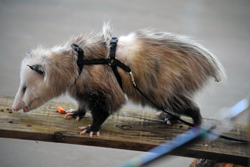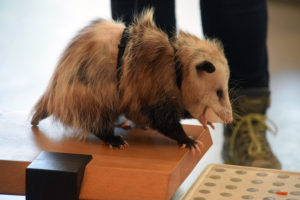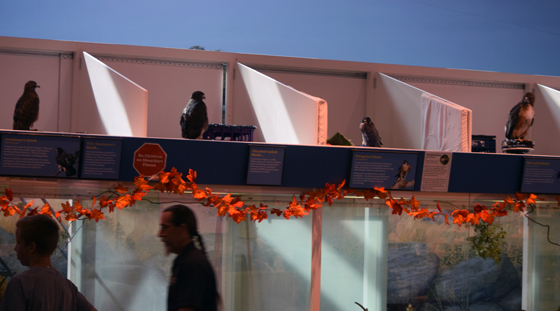Editor’s Note: Traveling by car between San Diego and the San Francisco Bay area where their son and three grandchildren are domiciled, co-publishers Don & Nancy Harrison like to explore California’s cultural attractions.
-Fifth in a Series –


WALNUT CREEK, California — Various passages in the Torah teach us not only to refrain from harming animals, but to be kind to them as well. That’s why it’s appropriate to think of the Lindsay Wildlife Experience as a place where ethical and religious precepts can be learned not only in words, but also in deeds.
Exodus 23:5 tells us that if we see a donkey struggling under a load, even if that donkey belongs to an enemy, we should help our enemy lighten the donkey’s load. Exodus 23:12 says that not only should Jews rest on the Sabbath, but so too should their animals. In Deuteronomy 22:6-7, we learn to shoo away a mother bird from a nest before we take away an egg, so as to cause the mother less stress. Deuteronomy 22:9 prohibits plowing with two kinds of animals, less they cause each other distress. Similarly, Deuteronomy 25:4 tells us not to muzzle an ox as it threshes; so that the ox won’t be frustrated about being surrounded by food which it cannot eat.
When people in Walnut Creek and the surrounding communities of Contra Costa County find an injured animal – be it a bird, reptile, mammal, or amphibian – they are encouraged to bring it to the Lindsay Wildlife Experience where, when possible, it will be nursed back to health and returned to the wild. If the animal’s injury is so serious that the animal could not survive in the wild, then the rescue center will become the animal’s home. In some cases, the animal will become an “ambassador” that is used to teach visitors about the habits of animals and their role in the ecosystem.
When I visited the Wildlife Experience recently with my son David and grandchildren Brian and Sara, we were able to witness the feeding of “Poppy,” a female opossum that had lost its tail, which made it difficult for Poppy to recline, balance, or suspend herself from a tree branch.
Food treats such as rat’s tails, pieces of dead mice, slices of various fruits and vegetables, were laid out on an obstacle course that had as its “grand prize” a hard-boiled egg. Poppy worked her way along the course, eating every dollop of food she encountered as educator Joshua Armosino shared with us and a score of other visitors some facts about opossums.
While some people mistakenly believe that an opossum is a rat-like rodent because of its long tail, in fact the opossum is a marsupial like the kangaroo, the koala, and the wallaby, all native to Australia. In that country, there also are possums, which are related but not the same as the opossums native to America.
Armosino told us that mother opossums are pregnant only two weeks before they give birth to their babies, which are approximately the size of jellybeans when born. The babies will find their way to their mother’s pouch and stay in there for about 2 ½ months. After they emerge, they will stay with their mothers for another five months, and then they will go off on their own to start new families. Opossums have a relatively short life span, typically between one and two years in the wild. Poppy, who doesn’t have to search for food at the Lindsay Wildlife Experience, may live a little longer.
In the wild, opossums play important roles. They will eat any rodents that they catch, keeping that population under control. They also eat dead animals, removing carrion and possible disease from the environment. They feast on hundreds of ticks in a week, thousands in a year, thereby helping to prevent such illnesses in humans as Lyme Disease, a painful, debilitating condition caused by the bacteria carried by ticks.
The reason that an opossum can eat ticks, carrion, and also digest poisonous and venomous creatures without consequence is because it has a special enzyme in its blood that breaks down the harmful substances.
“Scientists believe that these animals are very important for the future of our medicine,” Armosino said.
Turning to children who were seated on the floor in front to him, he added: “So the next time you see an opossum in our back yard, say, ‘Hey, opossum, thank you very much!”

While Armosino lectured, many eyes were trained on Poppy, who had made her way to the hard boiled egg at the end of the course and was happily munching it. When another member of the Lindsay Wildlife Experience staff held a microphone near Poppy, we could tell that so far as the Opossum was concerned the hard-boiled egg was lip-smacking good.
Armosino confided that back near Poppy’s enclosure, there were some very “smelly worms,” which she particularly enjoys. For Poppy, those worms are a special and delectable dessert.
Had we visited on another day, we might have met another kind of animal ambassador.
Watching the demonstration quietly from perches above display cases were a Swainson’s Hawk, which was found with an injured left eye; a Red-Tail hawk with an injured left wing, a Peregrine Falcon, with a broken wing, and two other red-tail hawks, one which was too dependent on handouts from humans to be able to survive in the wild, and the other which had suffered neurological damage. All of them now are domiciled at the Lindsay Wildlife Experience.

An in-house magazine has a picture of a porcupine ambassador on its cover, and an inside story told of an albino rattlesnake that had suffered eye damaged, multiple lacerations, a fractured jaw, and the loss of its tongue following an encounter with tree trimmers. Another story in the magazine told of a turkey vulture that had become incapacitated by lead poisoning – evidently because the dead animals it had eaten had been shot with lead bullets. The turkey vulture was restored to health and returned to the wild.
In addition to welcoming walk-in visitors, the Lindsay Wildlife Experience offers preschool programs, classes for home-schooled children, family excursions, and teacher training, among other programs.
Admission to the Lindsay Wildlife Experience at 1931 First Avenue in Walnut Creek is $10 general, $8 for seniors 65 and older, and $8 for children between the ages of 2 and 17. Tots younger than 2 are admitted free. The animal center is closed Mondays. More information may be found via this website.
*
Donald H. Harrison is editor of San Diego Jewish World. He may be contacted via donald.harrison@sdjewishworld.com